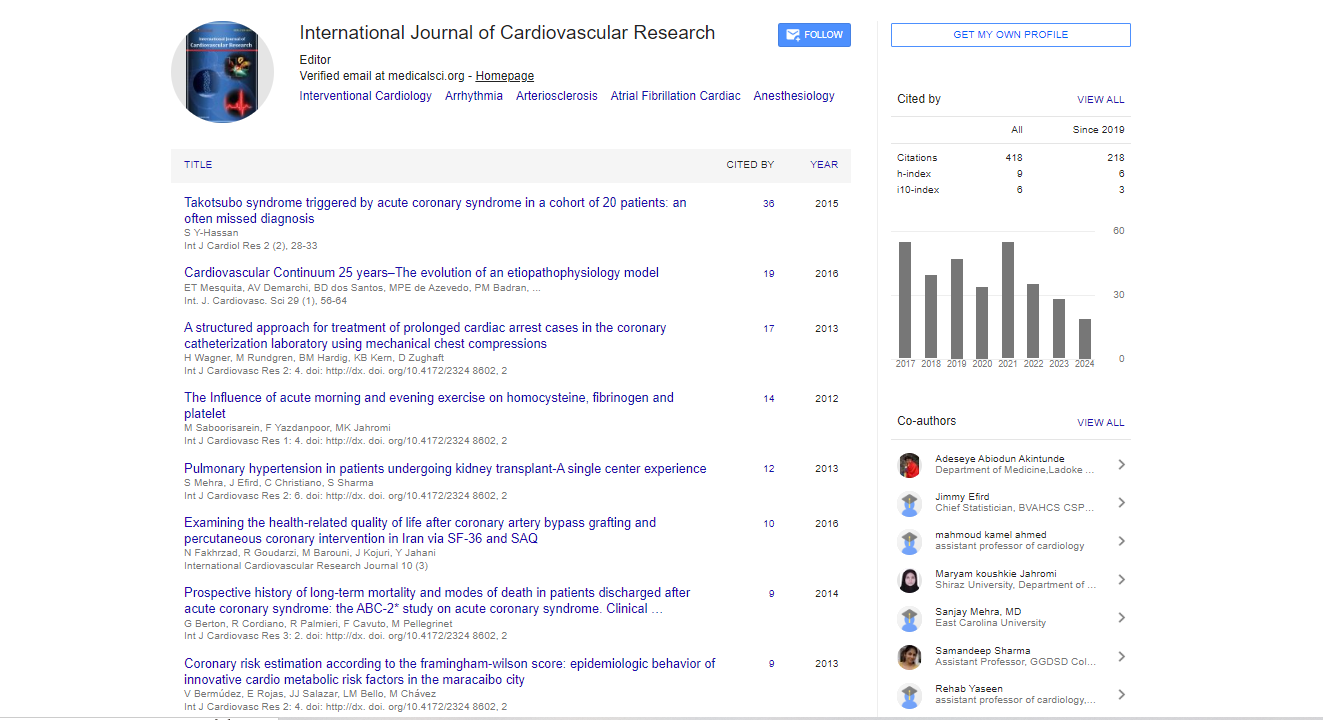Cardiovascular risk in adolescents and exercise issues in the congenital heart disease population
Claudia Montanaro
Royal Brompton Hospital, UK
: Int J Cardiovas Res
Abstract
In 2009 in the European Union the costs related to cardiovascular diseases amounted to E106 billion, representing ~9% of the total expenditure on healthcare. The scientific community has allocated significant funds to identify behaviour in the young which might adversely affect health in adult life. Based on the American Heart Association guidelines, the ideal cardiovascular health (iCVH) construct consists of 4 ideal health behaviors (nonsmoking, BMI <25 kg/m2, physical activity at goal level, and diet consistent with current recommendations) and 3 ideal health factors (untreated total cholesterol <200 mg/ dL, untreated BP <120/<80 mmHg, and untreated fasting glucose <100 mg/dL). Adolescents from a high socio-economic class are more likely to have a healthy diet, high levels of physical fitness and consequently lower cardiovascular risk. Only 47% of US adolescents and 54% of European adolescents exhibit at least 5 of the 7 iCVH components. Scientific literature shows that psychological and biological factors, social environment and community settings play an important role in the adolescent’s habits. Healthy habits and good physical activity is paramount for these patients. In the past, all patients with CHD were excluded from competitive sports mainly because of the risk of sudden death (SD). It has been noted that sudden death in CHD patients is generally rare. Aerobic activity and sport in general should always be recommended; there are exceptions as patients with severe left and/or right outflow tract obstructions, failing Senning or Mustard repairs, severe pulmonary hypertension, bicuspid aortic valve with severe aortic dilation and particular cases of anomalous coronary artery, in which it is reasonable to discourage competitive sports. Nowadays, available tools to estimate the risk of SD are appropriate interpretation of ECG, fibrosis evaluation with cardiac magnetic resonance and cardiopulmonary exercise test. Patients with congenital heart disease should be cared for in a tertiary centre where high level of expertise and knowledge informs any ad hoc counselling based on objective and self-perceived patient capacity and potentiality.
Biography
Claudia Montanaro is a Cardiologist with an interest in Congenital Heart Disease and Cardiac Imaging. She currently is a fellow at Royal Brompton Hospital in London, UK. She was trained at the Hospital San Raffaele in Milan, Italy. She is board certified in adult congenital heart disease echo (ESC). Her academic interests include outcome analysis in patients with congenital heart disease (in particular pulmonary atresia and ventricular septal defect) as well as 3D-CMR reconstruction of complex heart lesion. Her innovative research, supported by the Italian Society of Cardiology, is directed into the non-invasive detection of atrial fibrosis. She is a member of the editorial board of The International Journal of Cardiology. She is co-author of manuscripts published in peer reviewed journals and book chapters focused on congenital heart disease and heart failure.
 Spanish
Spanish  Chinese
Chinese  Russian
Russian  German
German  French
French  Japanese
Japanese  Portuguese
Portuguese  Hindi
Hindi 



